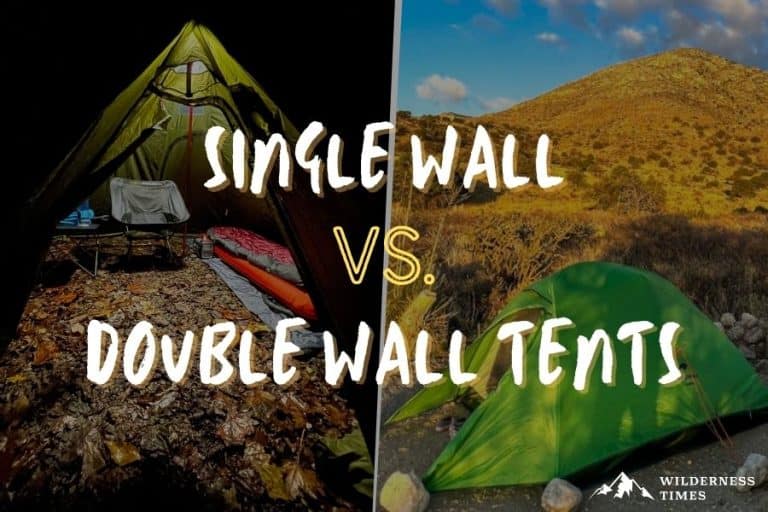If you’ve shopped for a tent, you’ve probably seen that tents usually fall into one of two categories: single wall or double wall tents.
These distinctions describe the layers of fabric over the tent structure:
A single wall tent will only have one layer of fabric.
The double wall tent contains two layers of fabric (the interior and the rain fly) stretched over one another.
Even though the physical variation is one layer of fabric, the differences between the designs can be staggering!
In this article, we’ll talk about each type of tent, the pros and cons of each type, and tips and tricks for using each one.
Table of Contents
ToggleWhat Is A Double Wall Tent?
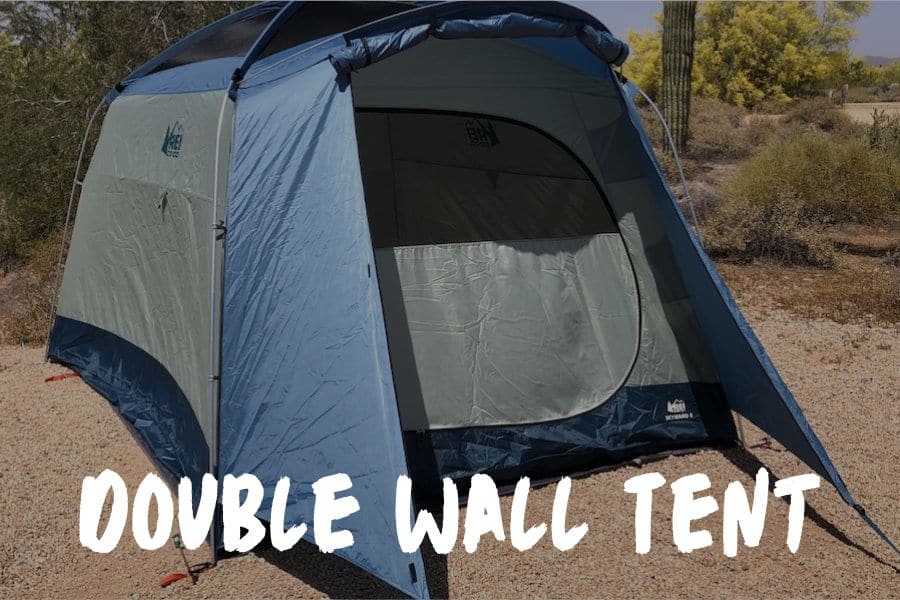
A double wall tent is a tent made up of two layers: an interior tent structure and an exterior rain fly layer that covers the entire tent structure.
Each layer of this type of tent serves a specific purpose, so you’ll need both layers to keep your tent secure and protected from the elements.
The interior tent layer provides structure to the tent model and is largely made from mesh, which is extremely breathable.
However, without the rain fly, it is exposed to the elements and lacks privacy.
Adding the rain fly protects the interior from rain, wind, and other debris.
Rain flies also include vestibules – small covered areas on the outside of the tent entrance for gear storage.
This allows you to store dirty gear outside of your tent interior.
Additionally, when both layers are up, they create a thin cushion of air around the interior tent and keep the entire tent insulated.
Even though this double layer has the potential to build condensation, the rain fly has windows and flaps for ventilation.
The main downside to double wall tents is that they can be heavier than their single wall counterparts.
Double wall tents are generally the tent of choice for most backpackers because they are effective in most weather conditions and are all-season tents.
Pros
- Effective insulation
- Superior protection in unpredictable weather
- Vestibule design adds exterior storage
Cons
- Heavier than single wall tents
- More complicated setup process
- Can take longer to dry
What Is A Single Wall Tent?
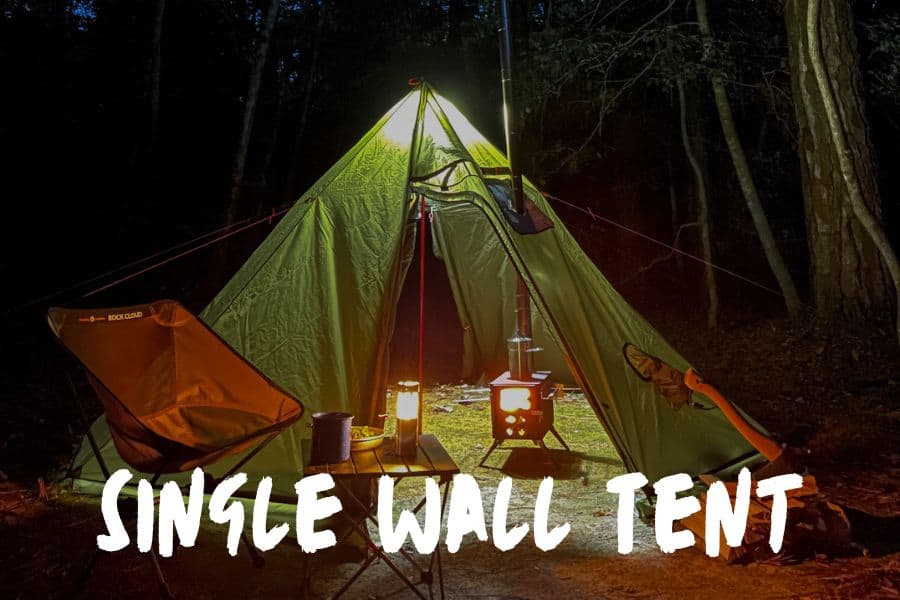
A single wall tent only has one layer of fabric that is designed to take on the qualities of both the interior tent layer and rain fly layer.
The fabric used is thicker than a normal tent layer and treated to be both water-resistant and breathable.
These tents are made to be ultralight and easy to pack down, so they’re great for backpackers on long treks who are concerned about weight.
Additionally, some single wall tents can use hiking poles in their setup.
So, the users can ditch their tent poles for even more lost weight.
The ideal camping scenario for single wall tents is temperate and predictable weather.
Single wall tents can have effective insulation in calm, snowy scenarios.
However, they do not stand up as well in active weather like blizzards, rainstorms, or humidity.
Because the rain fly is not separate in single wall tents, more condensation can build on the interior when camping in humid environments.
Pros
- Lightweight
- Less complicated design
- Easy setup
Cons
- Less reliable in unpredictable weather
- Less effective insulation
- Can build condensation on interior
- Ventilation exposes you to elements
Construction & Design Differences
When comparing single wall vs. double wall tents, you have to take certain factors into consideration.
Now that you know the main differences between the tent types, we can focus on when one tent type might be better than the other.
Here is a quick, head-to-head comparison of single wall vs. double wall tents based on these factors:
FEATURES | DOUBLE WALL TENT | SINGLE WALL TENT |
Warmth | ||
Ventilation | ||
Condensation | ||
Weight | ||
Setup Time | ||
Ease of Use |
Warmth
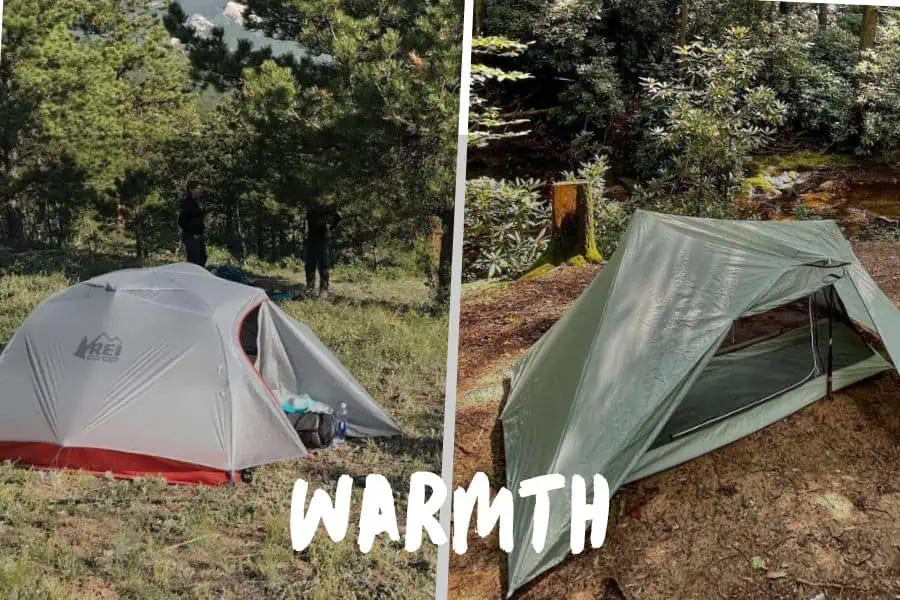
Double layer tents create a pocket of air between the tent structure and the rainfly.
This layer then stores body heat and maintains a warm interior of the tent in chilly weather.
Single wall tents are made with a thicker fabric that has the ability to keep some heat contained inside the tent.
However, because these tents lack the additional rain fly layer, they also lack the resulting pocket of insulated air.
Therefore, single wall tents will be less effective in keeping heat in the tent during cold weather.
So, double wall tents are the superior choice when it comes to insulation and warmth.
Ventilation

Single wall tents struggle with ventilation, especially in unfortunate weather conditions.
This is because their ventilation windows are on the sides of the tent structure.
When they’re open, the inside of the tent is directly exposed to the conditions outside.
Double wall tents have more ventilation options, and the ability to add a through breeze in the tent, even in inclement weather.
Condensation
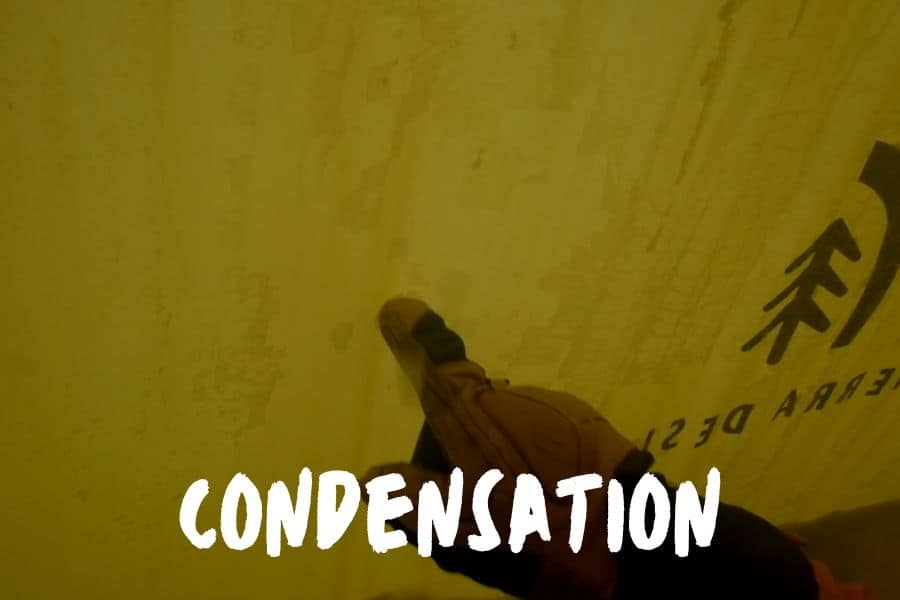
For the most part, it’s likely that you will see condensation in any tent you camp in – no matter the number of layers or walls.
However, double wall tents deal with condensation more effectively than single wall tents.
When condensation forms in a double wall tent, it’s generally going to form on the outer layer, or the rain fly, and drip down the sides.
Because the outer layer exists, there is less of a chance that any condensation will affect the interior of the tent.
You can also leverage the ventilation windows and roll-up sections to create a cross breeze to cut down on condensation.
When condensation forms in a single wall tent, there is no layer separating it from the tent interior.
So, that means the condensation can drip directly into your sleeping space.
There are measures you can take to prevent this from happening to a degree, like increasing ventilation by opening a window.
However, once a window is open you are then exposed to the elements on the outside of your tent.
Double wall tents are more effective at keeping down condensation without exposing the tent-goer to the outside.
Weight

If you’re the type of camper that is concerned about the weight you’re carrying on the trail, a single wall tent will be a great option for you.
Because they lack the additional rain fly layer, they can be much lighter in weight than their double-walled counterparts.
Single wall tents also generally use less poles and equipment than double wall tents.
This means you can ditch even more weight if you choose a single wall vs. double wall tent setup.
Set-Up Process
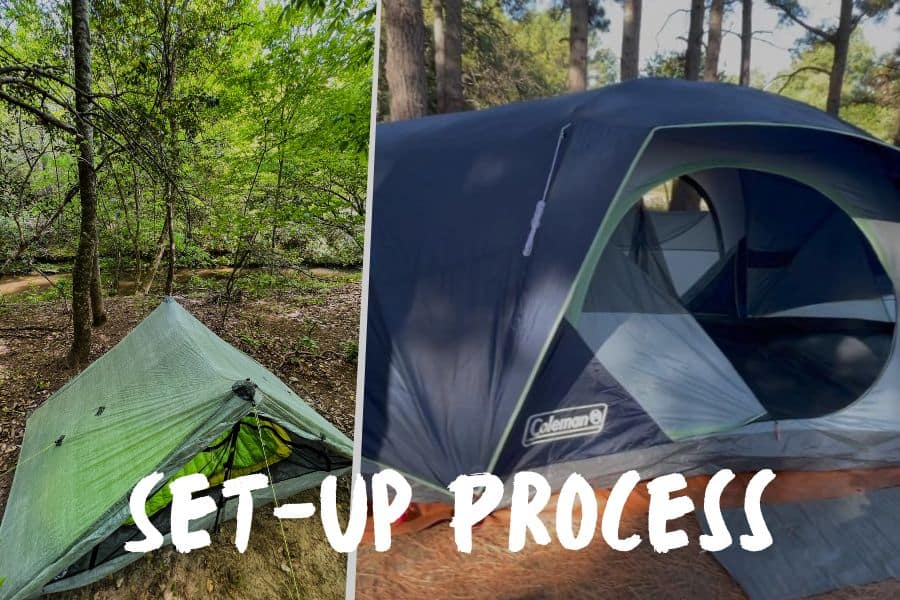
Single wall tents are made from simpler designs than double walled tents and are generally easier to set up.
If you’re someone who likes to pack up early and get on the trail, you might not want to be delayed by folding up the multiple layers of a double wall tent.
A single wall tent’s interior is also always protected from rain and snow because of its weatherproof materials – even during the setup process.
In comparison, the interior of a double walled tent will be exposed to the elements during the set up process, as you’re setting up multiple layers.
Overall, single wall tents will be faster and more protected from the elements while setting up.
Usability
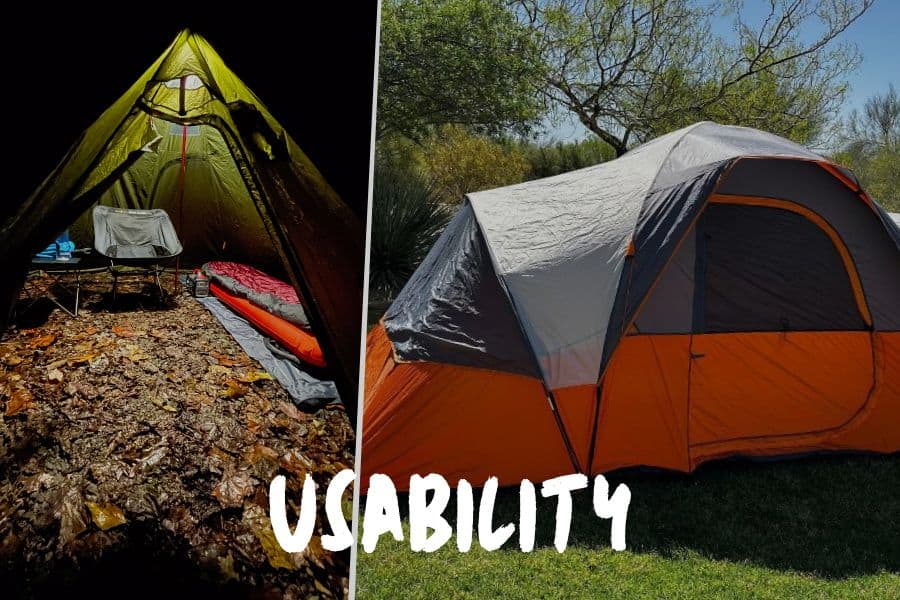
Because of all their layer advantages, double wall tents can be used year-round and in any weather condition.
Though, single wall tents are best used in temperate, arid, and predictable environments.
Comparing usability for single wall vs. double wall tents essentially comes down to preference and personal goals for your own tent.
Tips & Tricks For Single Wall Tents
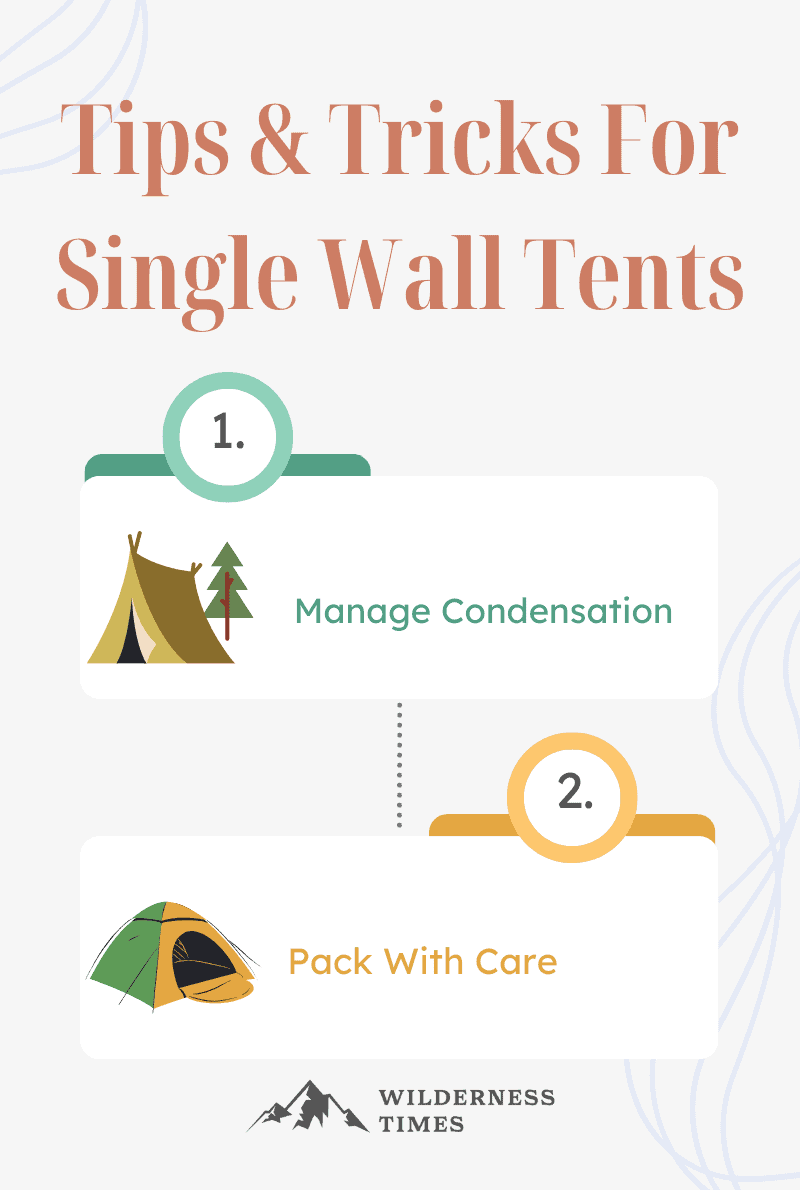
Single wall tents can be a great option for campers looking to pack light.
However, this type of tent may need specific care when it comes to condensation and packing.
Manage Condensation
One of the main challenges with single wall tents is trying to prevent condensation from forming on the structure and dripping onto your sleeping area.
The best way to prevent this condensation is to make sure you’re using your ventilation windows as much as possible.
Keeping air flowing throughout your structure will prevent excess moisture from forming in the structure.
Pack With Care
Single wall tents have only one layer of fabric protecting you from the elements.
Therefore, it’s really important that you pack your single wall tent with care, and ensure you have supplies for tent repair on hand.
You wouldn’t want to be stuck in the outdoors with a rip in your tent!
Tips & Tricks For Double Wall Tents
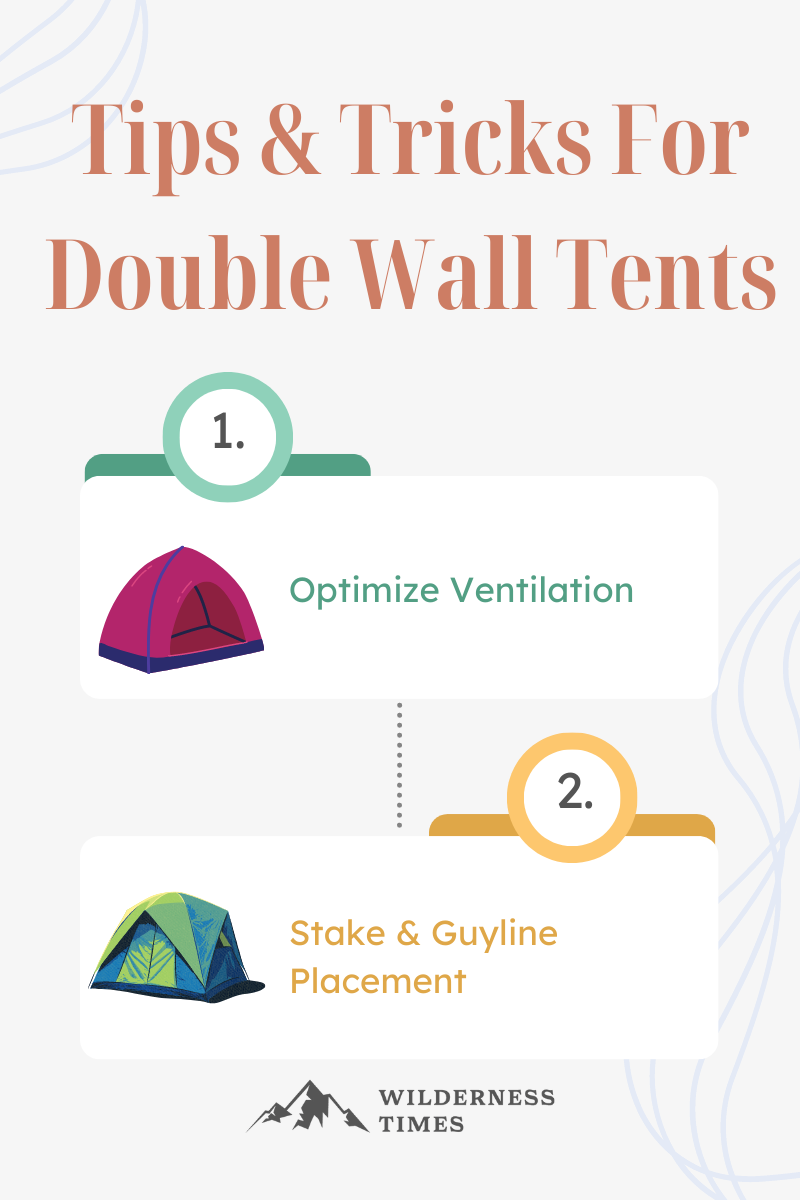
Even though double wall tents are the norm for most campers, there are a few quick tricks that can help you get an even better experience from them.
Optimize Ventilation
Having two layers is great for insulation but can sometimes cause overheating on a hot day.
To prevent this, open up some of the ventilation windows and roll-up sections to create a cross breeze through your tent.
Stake & Guyline Placement
Unlike single wall tents, double wall tents will require stakes and guylines to secure the rain fly to the ground.
When you’re setting up the guylines and stakes, make sure that they are securely attached and staked two to three feet from the base of your structure.
The rain fly material should be pulled taut to efficiently protect you against the wind and rain.
Check out our article, How to Set up A Tent, to learn more about this process.
FAQs
Are Single Wall Tents More Suitable For Specific Weather Conditions Compared To Double Wall Tents?
In general, a single wall tent is best in scenarios where there is dry, temperate, and predictable weather.
And, as long as you’re not dealing with high winds or blizzard conditions, it can keep you fairly warm in snowy conditions.
However, if you’re going into an area with unpredictable weather, or wet conditions, a double wall tent is going to be your best bet.
The double wall will keep you dependably warm and dry – no matter the changing weather.
Can A Double Wall Tent Be Used In Warmer Climates Without Excessive Heat Buildup?
The key to keeping yourself cool in warm weather is keeping a cross breeze throughout the tent.
Therefore, as long as you use the tent’s ventilation capabilities, your double wall tent can be used in warmer climates.
Do Single Wall Tents Provide Adequate Insulation For Colder Temperatures?
Single wall tents can keep you warm in colder weather, but their insulation is not as effective as double wall tents.
Are Single Wall Tents More Prone To Leaking During Heavy Rain Compared To Double Wall Tents?
Yes, because all water resistance in single wall tents relies on a single layer, they can be more prone to leaking than double wall tents.
Can I Use A Single Wall Tent In Areas With High Humidity Or Frequent Rain?
I would not recommend using a single wall tent in areas of high humidity or frequent rain.
Because they do not have an added layer, they will be more prone to forming condensation or leaking.
How Do Single Wall & Double Wall Tents Differ In Terms Of Set-Up Complexity?
Single wall tents are made of a much simpler design, so they have less pieces to put together and can be easier to set up on the campsite.
Conclusion
Now you know the difference between single wall vs. double wall tents!
Depending on your needs, either of these tents can serve you well on your next camping trip.
The rundown? If you’re worried about weight and ease of setup, go with a single wall tent. But if you’re worried about insulation with breathability, then a double wall tent is for you!
Happy camping!
Also Read


